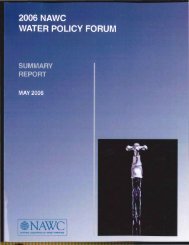BEECHER - NAWC
BEECHER - NAWC
BEECHER - NAWC
You also want an ePaper? Increase the reach of your titles
YUMPU automatically turns print PDFs into web optimized ePapers that Google loves.
--lWater ComparedStructural Changegovernments. The threat of municipal takeover can provide powerful performance incentivesfor many water utilities; in some cases, the takeover threat may be at least as effective aseconomic regulation (see Section 4).Contract operations also can be highly competitive at the time of bidding. Utilities oftencompete with engineering and management firms for the chance to operate utility facilities.However, the lengthy terms of many contracts (now ten to twenty years), along with the localgovernment ownership of assets, tend to be more characteristic of monopoly thancompetition. Long-term contracts for operations might prove contestable if the contractordoes. not meet performance standards.Although contestable market theory is useful forunderstanding the water sector, the technical,economic, and institutional features described inSection 2 limit competition in the industry. At thisjuncture, competition is not sufficient to supplantvital societal oversight mechanisms, such aseconomic regulation.Another important structural trend in the waterindustry is regionalization. Regional water utilitiescan achieve economies of scale, not only in wateroperations but also in environmental protection.ContestabilityWater supply is the most"monopolistic" of the utilities.However, water markets also canbe described as "contestable"because of the competition amongthe public and private ownershipforms, as well as the potential fora "takeover" of a smaller utilityby a larger one.Water does not respect local political boundaries; utilities organized along these boundariesgenerally are suboptimal. Water and wastewater utilities could be organized around largeenvironmental units (namely watersheds) that also correspond to local economic activity. Thebarriers to regionalization are substantial; most relate to the desire for local governmentalcontrol over water utilities.Aggregate national trends in employment in the utility sectors are revealing of the changing .economic character of the industries. In the telecommunications area, the divestiture ofAT&T triggered a decline in employment. Not surprisingly, the highly service-oriented(versus production-oriented) telecommunications sector continues to be a substantialemployer. In the past few years, the slight increase (based on more detailed statistics) isassociated with the surge in cellular services. The energy sectors indicate declines inemployment. Further declines in employment could occur with electricity restructuring, asutilities downsize in order to become more efficient and more competitive.;; Between 1986 and 1995, the electricity industry workforce declined by 100,000; real salariesand wages declined by 28 percent. 22 This translates to a reduction in wage costs from about0.7 cent per kWh in 1986 to about 0.5 cent per kWh in 1995. Electricity utilities also arepreparing for competition through mergers and acquisitions. Between 1986 and 1985, the22Energy Information Administration, The Changing Structure of the Electric Pawer Industry: An Update(Washington, DC: EIA) (http://www.eia.doe.gov/cneaf/electricitv/chg str/chapter9.htrnl).<strong>NAWC</strong> 65 September 1998
















